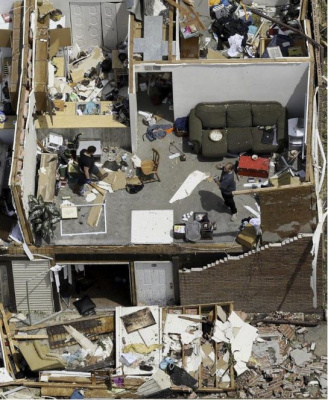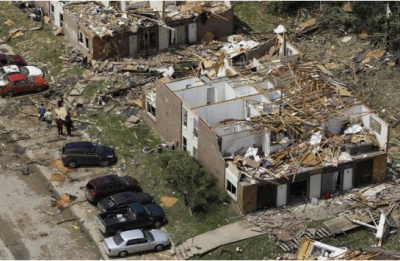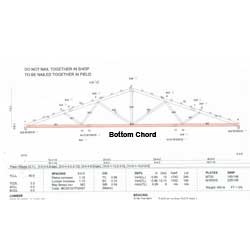Tornadoes Reek Havoc, Don’t Let Them Wreck You
Excerpts in italics below are from an article first appearing in SBC Magazine June 3, 2019:
“In the past few weeks, weather systems throughout Texas, Oklahoma, Missouri, Indiana and Ohio have had a significant impact on the built environment. As is well known, tornadoes cause severe stress on buildings where the high localized wind loading conditions find the weak point of the structure quickly. This usually is at the location of a wood nail, wood connector or anchor bolt connection, or in our testing experience, a knot or slope of grain deviation in a lumber tension member. An interesting point is that most studs in wall systems are meant to see compression forces not tension, where studs in tension may also be a structural weak point.
As the pictures herein attest, finding the key building material weak point that caused the structural performance to be a debris field is challenging, if not impossible, to do.
 Tornado damage in Jefferson City, Mo. as seen on Thursday, May 23, 2019. Photo by David Carson, St. Louis Post-Dispatch.
Tornado damage in Jefferson City, Mo. as seen on Thursday, May 23, 2019. Photo by David Carson, St. Louis Post-Dispatch.
Questions that need to be sincerely addressed follow, which include but are certainly not limited to:
What were the as-built conditions?
Was the building built to code?
Which aspects of the structure were built to code?
Which aspects of the structure were not built to code?
What is the cause/effect analysis for each code compliant and each non-code compliant condition?
It is obvious that proper construction implementation is key to satisfactory building material performance. Paying close attention to all connecting systems that make up the load path is essential.
The most important outcomes of poor building performance in a high wind or seismic event are that no one gets hurt; the construction industry continues to learn and evolve; and design and installation best practices improve.
 The entire construction industry can greatly benefit by staying focused on providing framer-friendly details that are easy to understand and implement. It’s critical that we come together with the goal of fostering innovation, using accepted engineering practice, creating installation best practices, working closely with professional framers and assisting building departments to focus inspections on key load path elements. We all are educators. By working together, we will significantly improve the built environment.”
The entire construction industry can greatly benefit by staying focused on providing framer-friendly details that are easy to understand and implement. It’s critical that we come together with the goal of fostering innovation, using accepted engineering practice, creating installation best practices, working closely with professional framers and assisting building departments to focus inspections on key load path elements. We all are educators. By working together, we will significantly improve the built environment.”
Mike the Pole Barn Guru adds:
Readers will note, these failures are in stick frame construction. Certainly there were also pole barns failing in tornado areas as well, however it is my opinion post frame buildings, engineered to withstand appropriate wind speeds, and assembled according to engineering documents would survive these storms – preventing both loss of property and life.
Code requirements are merely minimum design standards and often do not address severity of real life events. My recommendation is when in doubt, design to higher loads than minimum, in most cases these higher design loads involve a nominal investment and your family and expensive possessions deserve this type of protection.
Talk with your Hansen Pole Buildings’ Designer today at 1(866)200-9657 to find out what a lifetime of protection will involve.








